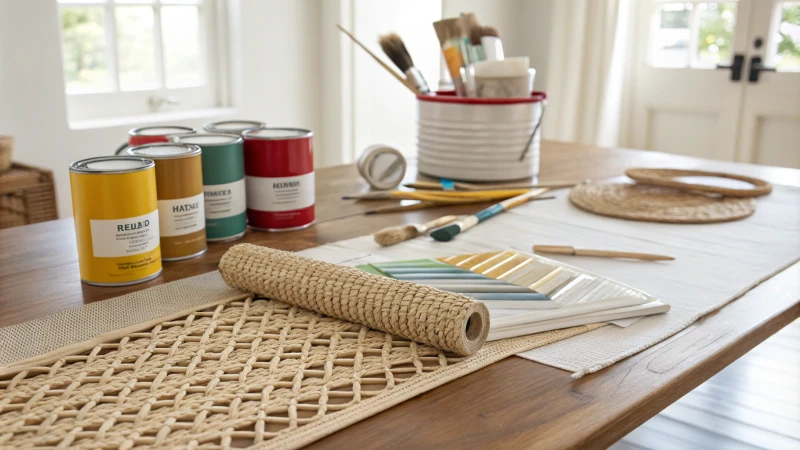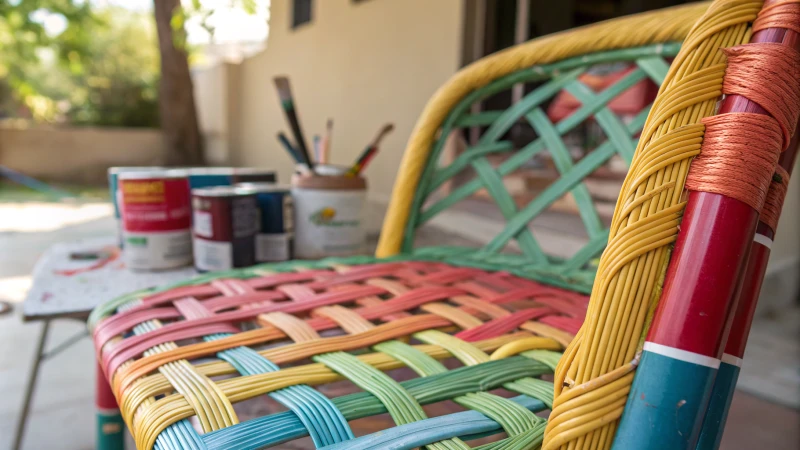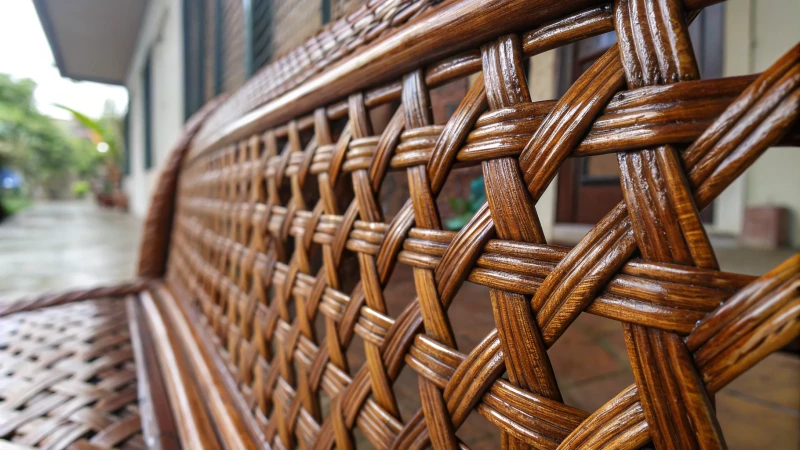
Are you considering refreshing your rattan webbing? I want to tell you about my experience!
Yes, you may paint rattan webbing! Using suitable techniques and materials, painting improves the look of your rattan furniture or decor. This post shares important tips and tricks for a successful change. Keep reading to find practical advice on the best types of paint and ways to apply it. Discover color choices to achieve beautiful results.
When I first thought about painting my rattan webbing, I felt excited but unsure. Could I truly change my old furniture into something new and colorful? Spoiler alert꞉ Yes, you absolutely could! Using the correct methods and tools, painting breathes new life into your rattan pieces. They become uniquely yours.
I remember the thrill of picking colors that showed my personality and style. The moment I saw the change was magical!
Rattan webbing can be painted successfully.True
With proper techniques and materials, painting rattan webbing enhances its appearance.
All types of paint are suitable for rattan webbing.False
Not all paints adhere well; specific types are recommended for best results.
What Types of Paint Are Best for Rattan Webbing?
Choosing the right paint for rattan webbing might seem intimidating. Still, this experience is valuable. Every paint option has unique qualities. These paints truly change your projects.
Acrylic, spray, chalk and oil-based paints are the best choices for painting rattan webbing. Each type has unique benefits. These paints suit different projects. They provide durability and look nice.

When selecting paint for rattan webbing, it’s crucial to consider various factors that influence both aesthetics and durability. Here are some types of paint that can be effectively used:
1. Acrylic Paint
Acrylic paint quickly became my top choice for rattan webbing due to its versatility and ease of use. It sticks well to natural fibers, making everything I paint look bright and last long.
Key Features:
- Quick Drying: Allows for faster project completion.
- Water-Based: Easier cleanup with soap and water.
- Flexibility: Stretches with the material, preventing cracking.
2. Spray Paint
Spray paint has helped me many times by providing a smooth, even coat that can reach intricate areas of rattan webbing without brush strokes. It’s ideal for those looking for a quick application method!
Key Features:
- Even Coverage: Reduces the risk of drips.
- Variety of Finishes: Available in matte, glossy, and satin finishes.
- Accessibility: Easy to apply on hard-to-reach spots.
3. Chalk Paint
Chalk paint changed the game for me when I wanted a trendy matte finish on furniture. Its unique texture gives my projects a vintage charm that I really love!
Key Features:
- No Primer Needed: Can be applied directly on clean surfaces.
- Easy Distressing: Perfect for achieving a vintage look.
- Eco-Friendly Options: Many brands offer low-VOC or zero-VOC formulations.
Painting Techniques for Rattan Webbing
How I apply paint affects how my pieces look in the end. Here are some techniques I use:
| Technique | Description | Benefits |
|---|---|---|
| Brushing | Use a soft brush to apply paint evenly. | Allows for detail work; good for touch-ups. |
| Spraying | Apply paint in light coats from a distance. | Quick application; even coverage without brush marks. |
| Dipping | Submerge smaller pieces in paint for full coverage. | Ideal for complete saturation of color; ensures every nook is covered. |
4. Oil-Based Paint
Though I don’t often use them, I value oil-based paints for their durability, especially suitable for outdoor furniture exposed to the elements as they handle weather better than most!
Key Features:
- Long Lasting: Resists wear and tear effectively.
- High Gloss Finish: Offers a striking appearance.
- Requires Solvent Cleanup: More challenging cleanup than water-based options.
Choosing the right type of paint has changed my rattan webbing projects significantly! To ensure long-lasting results, consider factors like where your furniture will be used (indoors vs outdoors) and the level of wear it will endure.
For more detailed tips on application techniques and color selection, visit our resources here1.
Acrylic paint is ideal for rattan webbing projects.True
Acrylic paint adheres well to natural fibers and offers durability, making it suitable for rattan webbing.
Oil-based paint is the best choice for indoor rattan furniture.False
Oil-based paints are typically more suited for outdoor use due to their durability against elements, not ideal for indoor furniture.
How Do You Prepare Rattan Webbing for Painting?
Excited to refresh your rattan webbing? Follow these steps to get it ready for painting. Trust me, the process is simpler than expected. The transformation looks amazing!
Preparing rattan webbing for painting starts with cleaning it very well. Lightly sand the surface after cleaning. Next, pick a suitable paint. You might choose to apply a primer. Evenly apply the paint. Allow enough drying time between each step. This gives a great finish! Let’s explore more details.

Step 1: Cleaning the Rattan Webbing
Prepare rattan webbing for painting by following some simple steps. First, clean the surface very well. Use a soft brush or cloth to remove dust and debris. For deeper cleaning, mix a gentle detergent with warm water.
Gently scrub the surface with a soft sponge, paying special attention to any crevices. Rinse thoroughly with clean water and allow it to dry completely.
Tip: Avoid using harsh chemicals as they may damage the rattan fibers. If you’re unsure, test a small area first.
Step 2: Sanding the Surface
Next, sand it lightly. Once the webbing is clean and dry, lightly sand the surface with fine-grit sandpaper (220-grit). This step is essential as it helps the paint adhere better to the rattan. Sanding also smooths any rough areas, ensuring a more uniform finish.
- Sanding Technique:
- Use a sanding block for larger areas.
- For intricate designs, wrap sandpaper around your fingers or use a sanding sponge.
Step 3: Choosing the Right Paint
Choose the right paint for the job. Select a high-quality paint suitable for porous surfaces. Acrylic paint is often recommended due to its versatility and ease of application. Make sure it’s compatible with rattan.
| Type of Paint | Benefits | Best Use |
|---|---|---|
| Acrylic | Quick-drying, flexible | Indoor furniture |
| Spray Paint | Even coverage, quick application | Decorative items |
| Chalk Paint | Matte finish, easy to distress | Vintage look furniture |
Note: Always check the label for compatibility with rattan webbing.
Step 4: Priming (Optional)
Consider using a primer if needed. While not always necessary, applying a primer can enhance the paint’s durability. Choose a water-based primer designed for natural materials.
Apply it using a brush or roller and let it dry completely before moving on to paint.
Step 5: Painting the Rattan Webbing
Finally, apply the paint evenly. When ready to paint, use a brush or spray can for even application. If using a brush, apply thin coats to avoid drips. Two to three coats may be needed for solid coverage.
- Application Tips:
- Start from one end and work your way to the other.
- Allow each coat to dry thoroughly before applying the next.
Step 6: Finishing Touches
Let each layer dry properly for the best look! After your final coat of paint has dried, inspect for any missed spots or uneven areas. Touch these up as needed. Once satisfied, allow the webbing to cure fully according to the paint manufacturer’s recommendations before using the furniture.
This preparation process not only enhances the look of your rattan webbing but also extends its lifespan by protecting it from wear and tear. For more detailed insights on furniture restoration, consider checking out restoration techniques2 or best paints for rattan3.
Rattan webbing must be cleaned before painting.True
Cleaning rattan webbing removes dust and debris, ensuring better paint adhesion and finish quality.
Sanding is optional when preparing rattan for painting.False
Sanding is essential as it helps the paint adhere better to the rattan surface, ensuring a uniform finish.
What Techniques Should You Use When Painting Rattan Webbing?
Do you ever think about giving new energy to your rattan furniture? I remember being really happy when I turned an old, worn-out piece into something bright and eye-catching in my home. Let’s look at some useful methods to refresh your furniture. These techniques will help keep its unique charm intact.
Painting rattan webbing successfully begins with cleaning it well. Choose the right type of paint, such as acrylic or spray paint. Use effective methods to apply the paint, like brushing or spraying. A protective sealant provides extra durability. Remember to seal it.

Preparing Your Rattan Webbing for Painting
Before you start painting your rattan webbing, it’s essential to properly prepare the surface. Start by cleaning the webbing thoroughly to remove any dust, dirt, or grease. Use a soft cloth and a mild detergent solution. Make sure to dry it completely before applying any paint.
Next, inspect the rattan for any damages or loose strands. If you find any, consider using a pair of scissors to trim them, ensuring that the overall appearance remains tidy.
Selecting the Right Paint
Choosing the right type of paint is crucial for achieving a professional finish on your rattan webbing. Here are some options:
| Paint Type | Features | Best Use |
|---|---|---|
| Flexible Paint | Stays flexible to prevent cracking | Indoor and outdoor furniture |
| Spray Paint | Quick application, even coverage | Outdoor furniture |
| Acrylic Paint | Water-based, fast-drying | Indoor furniture |
When selecting paint, look for ones specifically designed for flexibility to avoid cracking as the rattan bends and moves.
Application Techniques
When it comes to applying paint, you can choose from several techniques:
- Brushing: Use a high-quality brush to carefully apply paint in even strokes. This method allows you to control the amount of paint applied and is great for detailed work.
- Spraying: For an even coat, spray paint can be a time-saver. Hold the spray can 6-12 inches away from the surface and apply light, even coats.
- Dabbing: If you’re looking to create a textured finish, consider using a sponge to dab paint onto the webbing.
Each technique can yield different results, so experimenting on a small section first can help determine what works best for your desired outcome. Check out these application tips4 for more guidance.
Finishing Touches
Once the paint has dried completely, it’s important to add a protective finish. A clear sealant will help protect your newly painted rattan from scratches and fading.
| Sealant Type | Benefits |
|---|---|
| Polyurethane | Durable, water-resistant |
| Acrylic Sealant | Non-yellowing, easy to apply |
| Wax Finish | Adds a warm glow and soft sheen |
Apply the sealant using a clean brush and follow the manufacturer’s instructions for drying times.
Additional Tips
- Always work in a well-ventilated area to avoid fumes.
- Wear gloves and a mask if necessary to protect yourself from inhaling paint particles.
- Test your chosen paint on a small, inconspicuous area of the webbing first to ensure compatibility and satisfaction with color.
For more detailed insights into painting techniques, feel free to explore this painting guide5.
Acrylic paint is best for indoor rattan furniture.True
Acrylic paint is water-based, fast-drying, and flexible, making it ideal for indoor rattan furniture.
Spray paint should be used for indoor furniture.False
Spray paint is recommended for outdoor furniture due to its quick application and even coverage, not indoor use.
What Are the Limitations of Painting Rattan Webbing?
Have you ever thought about painting rattan webbing? This idea has crossed my mind as well. Knowing its limits might really help with your next furniture piece.
Painting rattan webbing presents challenges such as durability issues and uneven absorption. Painting may not last long or look consistent. Choose the right paint for a good finish. Acrylic or spray paint work well. Preparation before painting is very important.

Understanding the Material
Rattan webbing is popular with furniture designers due to its lightness and strength. However, its unique properties can present certain challenges when it comes to painting.
The porous feature of rattan allows for breathability, which is excellent for furniture durability but can also absorb paint unevenly. This might cause a blotchy look if not done correctly. I faced this problem while painting a rattan chair for my living room. The color I wanted did not appear smooth and bright; instead, the result was patchy, making me doubt my skills.
For more details on rattan webbing properties, check out this in-depth guide6.
Suitable Paint Types
Choosing the right paint is very important when considering a paint job on rattan webbing. Here’s a breakdown:
| Paint Type | Pros | Cons |
|---|---|---|
| Acrylic Paint | Fast drying, easy to clean | May require primer |
| Spray Paint | Smooth finish, even coverage | Fumes can be toxic |
| Chalk Paint | Matte finish, no primer needed | Less durable |
Opting for high-quality paint works better as it helps the paint stick and last longer. For a detailed analysis of paint types, read more here7.
Preparation and Technique
I discovered that preparation matters a lot before painting. It’s like setting a stage for a show! Here are some techniques:
- Cleaning: A gentle soap and water mix cleans dirt well.
- Sanding: Light sanding with fine-grit sandpaper helps the paint stick.
- Priming: A primer specifically designed for porous surfaces changes everything and helps achieve a smoother result.
For tips on effective preparation methods, check this resource8.
Potential Limitations
Painting rattan webbing is exciting but has limits:
- Durability: Painted areas might chip or wear over time, especially in high-use areas.
- Flexibility: Rattan can bend; thus, paint might crack when it does.
- Color Change: Painting alters rattan’s natural look which some users might find undesirable.
For insights into maintaining the painted finish, explore this helpful article9.
Alternatives to Painting
If painting seems too hard, I found exciting alternatives:
- Staining: This keeps the natural color and lets rattan’s beauty shine without covering it up completely.
- Natural Oils: They protect rattan while preserving its original look intact.
- Reweaving: Refreshing the webbing sometimes updates the furniture without paint.
For a comprehensive guide on alternatives to painting rattan, refer to this detailed overview.
Rattan webbing can absorb paint unevenly.True
Due to its porous nature, rattan webbing may lead to blotchy paint applications if not prepared properly.
All types of paint are suitable for rattan webbing.False
Not all paints adhere well to rattan; specific types like acrylic and chalk are recommended for best results.
Conclusion
This guide explores how to successfully paint rattan webbing, including recommended paints, preparation techniques, and application methods for a durable and attractive finish.
-
Discover expert recommendations on choosing the right paint for your rattan projects, ensuring durability and style. ↩
-
Discover expert tips on preparing rattan for painting that can enhance your DIY project significantly. ↩
-
Find out which paints work best for rattan surfaces and ensure a long-lasting finish. ↩
-
This link offers in-depth tips on painting techniques tailored specifically for rattan, ensuring you achieve the best results possible. ↩
-
Explore this guide for comprehensive tips on preparing rattan webbing for painting and selecting the right materials. ↩
-
Learn about the limitations of painting rattan webbing to ensure your project meets your expectations. ↩
-
Discover the best types of paint for rattan webbing and how to apply them effectively. ↩
-
Find out preparation tips for painting rattan webbing for optimal results. ↩
-
Explore alternatives to painting that maintain the aesthetic of rattan furniture. ↩


